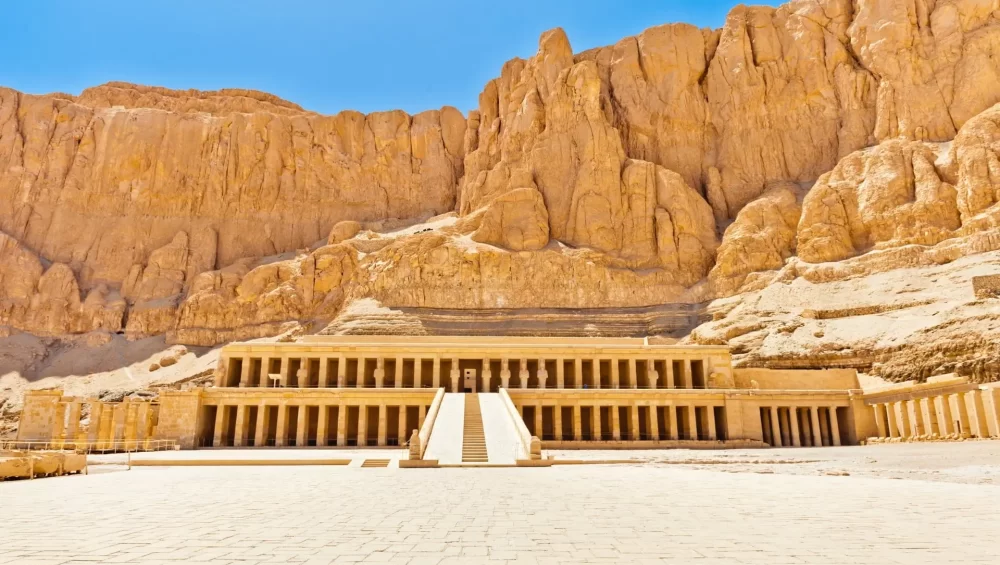Queen Hatshepsut, the fifth pharaoh of Egypt’s 18th Dynasty, remains one of the most remarkable figures in ancient Egyptian history. Known for her strength, intelligence, and visionary leadership, she defied societal expectations to become one of Egypt’s most successful rulers. Her name, Hatshepsut, translates to “the most famous noble lady,” and she truly lived up to it by transforming Egypt into a prosperous and powerful nation during her 21-year reign.
Hatshepsut’s Early Life and Rise to Power
Born as the eldest daughter of King Thutmose I and Queen Ahmose, Hatshepsut was thrust into the complex dynamics of the royal court from an early age. After her father’s death, Hatshepsut married her half-brother, King Thutmose II, and together they ruled Egypt. However, following his sudden death, Hatshepsut’s path to power was far from smooth.
To solidify her position as ruler, Hatshepsut made a bold move. In an era where female pharaohs were rare, she proclaimed herself as the daughter of the god Amun, securing divine legitimacy for her reign. She even depicted herself as a man in carvings, wearing a false beard to emphasize her authority and challenge the gender norms of the time.
Overcoming Obstacles and Securing Her Throne
Facing resistance from those who believed a woman was unfit to rule, Hatshepsut took decisive steps to establish her reign. While her stepson, Thutmose III, was technically the rightful heir, he was too young to govern, so Hatshepsut took on the role of both regent and, later, sole ruler. Some rumors suggest she may have orchestrated her husband’s death to gain full control, but there is no solid evidence to support this theory.
Hatshepsut’s leadership was characterized by peace, diplomacy, and a focus on Egypt’s economy, setting her apart from many of her male counterparts. She proved that a woman could rule as effectively, if not more so, than any man before her.
Key Achievements in Trade, Architecture, and Diplomacy
Under Hatshepsut’s reign, Egypt flourished economically and culturally. She prioritized trade, establishing vital commercial links with regions such as Punt (modern-day Somalia), which greatly boosted Egypt’s wealth. Additionally, her reign was marked by an emphasis on monumental architecture and the restoration of Egypt’s prosperity after years of instability.
One of Hatshepsut’s most awe-inspiring accomplishments is her Mortuary Temple at Deir el-Bahari in Luxor. This architectural marvel, designed by her trusted advisor Senmut, stands as a testament to her legacy. It is widely considered one of the most beautiful temples in Egypt, blending seamlessly with the surrounding cliffs. Although the true nature of Hatshepsut’s relationship with Senmut remains a topic of speculation, their collaboration in this project is undisputed.
Legacy and the Erasure of Her Name
Despite her tremendous achievements, Hatshepsut’s legacy faced a deliberate attempt at erasure by her stepson, Thutmose III. After her death, he ordered the destruction of her monuments and the removal of her name from temples across Egypt—a process known as “damnatio memoriae.” However, her memory could not be fully erased. Hatshepsut’s contributions to Egypt’s greatness are still celebrated today, and her legacy continues to inspire generations.
Hatshepsut’s Lasting Impact
Queen Hatshepsut’s reign stands as one of the most extraordinary chapters in Egypt’s long and storied history. She proved that leadership is not confined to gender, and her ability to maintain peace and prosperity during her reign left an indelible mark on Egypt. Her mortuary temple, despite attempts to erase it, remains a symbol of her vision and influence.
Queen Hatshepsut remains one of Egypt’s greatest pharaohs, a leader who demonstrated that with determination and strategic brilliance, anyone can leave a legacy that lasts for millennia.
Book now you Egypt tour package and experience the beauty of Egypt!




